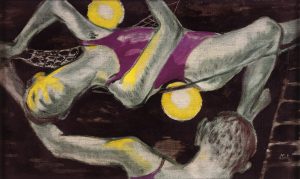23.09.2023 –
28.01.2024
PAUL STRECKER – Magic of the Curtain

With the cabinet exhibition »Paul Strecker – Magic of the Curtain« the Kunsthaus Dahlem shows works of the unusual and versatile artist. His work includes paintings, drawings and stage designs as well as literary texts. In addition, as a teacher and critic, he influenced art history in his adopted home of Paris, where he lived for 20 years, as well as in his later retreat of Berlin. After his early death in 1950, three retrospectives were dedicated to him in Wiesbaden, Berlin and Bremen. Today, his diaries are an important source for historians and art historians. They attest to Strecker’s extensive network of contacts with various artists of the 20th century, including Arno Breker, for whom the building of the Kunsthaus Dahlem was erected as a studio and propaganda building under National Socialism.
About the artist
Born on August 13, 1898 in Mainz as the son of the successful music publisher Ludwig Strecker, Paul Strecker grew up in middle-class circumstances. After graduating from school, he attended the private painting school Heymann and Knirr in Munich from 1918 and transferred there to the Academy of Fine Arts in 1920. Already during his studies he established contacts with the international art scene. The influential art dealers Alfred Flechtheim, Paul Cassirer and Karl Buchholz promoted the young talent early on. On their recommendation, Strecker went to Paris in 1924, where he remained until 1944 and thus spent the largest part of his creative period there.
In the midst of the lively Parisian art scene of the 1920s, he allowed himself to be imbued with the artistic and intellectual atmosphere of the city. He made contacts with artists, critics, and gallery owners and recorded encounters and inspirations in his diaries. Strecker’s growing social and artistic environment led to a rapid development of his artistic style. At the same time, with the onset of National Socialism, he collaborated with the German Ministry of Propaganda and thus supported the foreign cultural-political interests of the German occupying power. In 1944 Strecker moved to Berlin and in the few years before his death in 1950 he developed an intensive artistic activity as a painter, stage designer and author. In addition, in 1946 he was hired by Karl Hofer at the Hochschule für bildende Künste as a »teacher of painting and drawing«. At the same time, he produced numerous stage designs for the Berlin Theater and the Deutsche Oper.
On the exhibition
Paul Strecker’s idiosyncratic style took a fascinating turn in the immediate postwar period. Magicians, artists, and actors give the diffuse light and space formations in Strecker’s paintings the appearance of performances. The sometimes irritating acts thus appear as enraptured and deeply unsettling constellations of bodies and relationships. The exhibition »Paul Strecker – Magic of the Curtain« is dedicated to this unusual subject. In the context of post-war history, his works can undoubtedly be read as testimonies of a split culture and society.
The cabinet exhibition »Paul Strecker – Magic of the Curtain« focuses on the artist’s late work, created in Berlin, and thus pays tribute to his significance for German postwar art. Selected works from his extensive œuvre are complemented by excerpts from his diaries, providing insight into Paul Strecker’s life and work in Berlin in the late 1940s.
Curator: David Ludwig, Scientific Trainee at Kunsthaus Dahlem
Opening: Friday, 22.09.2023 | 19:00